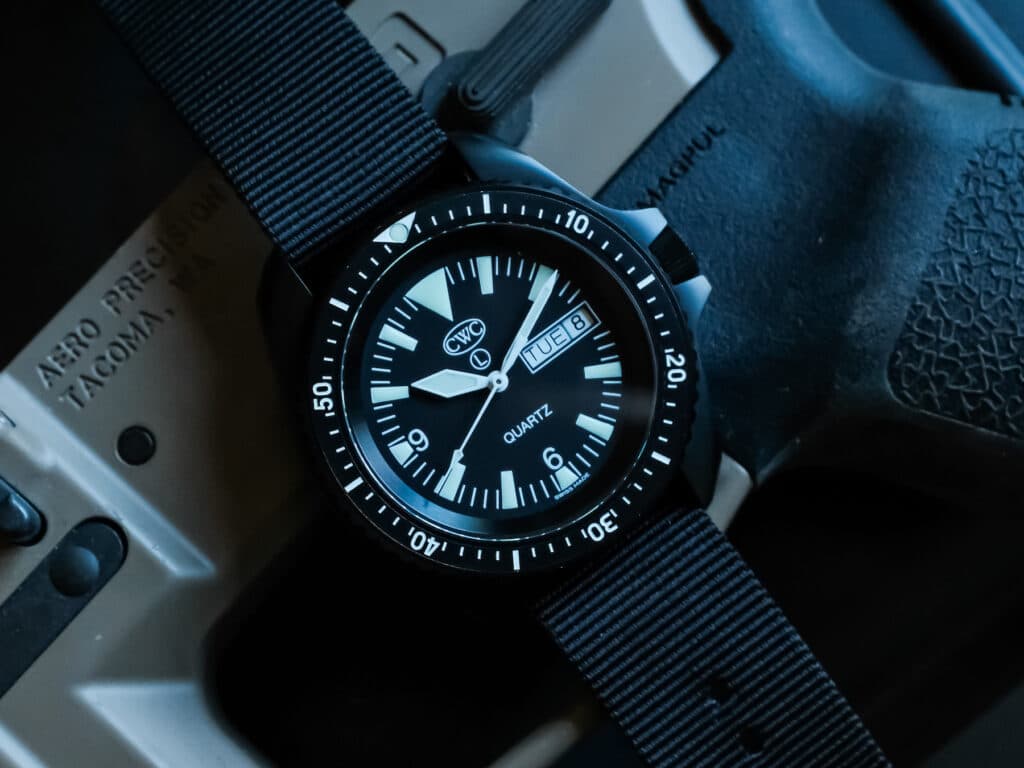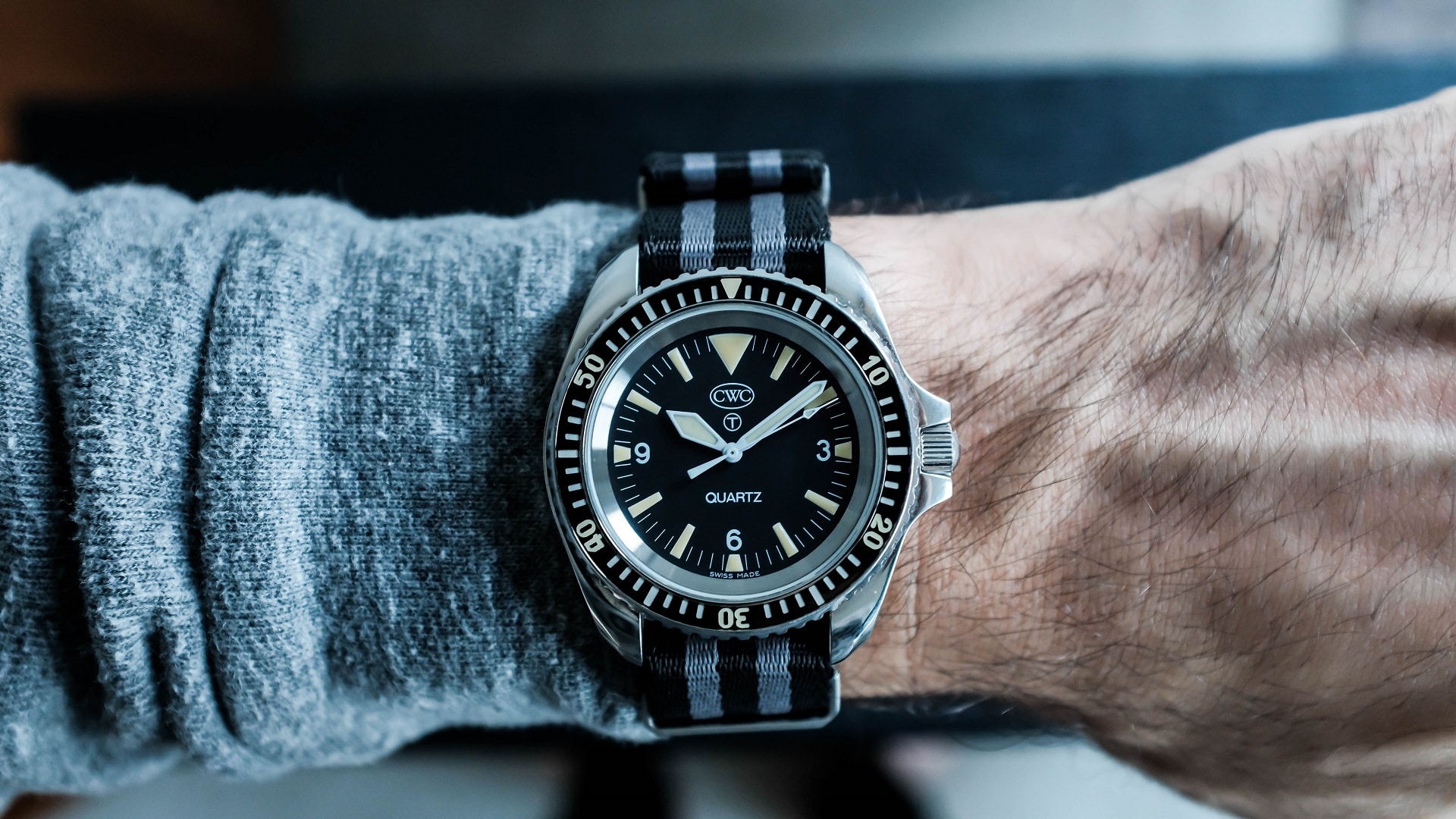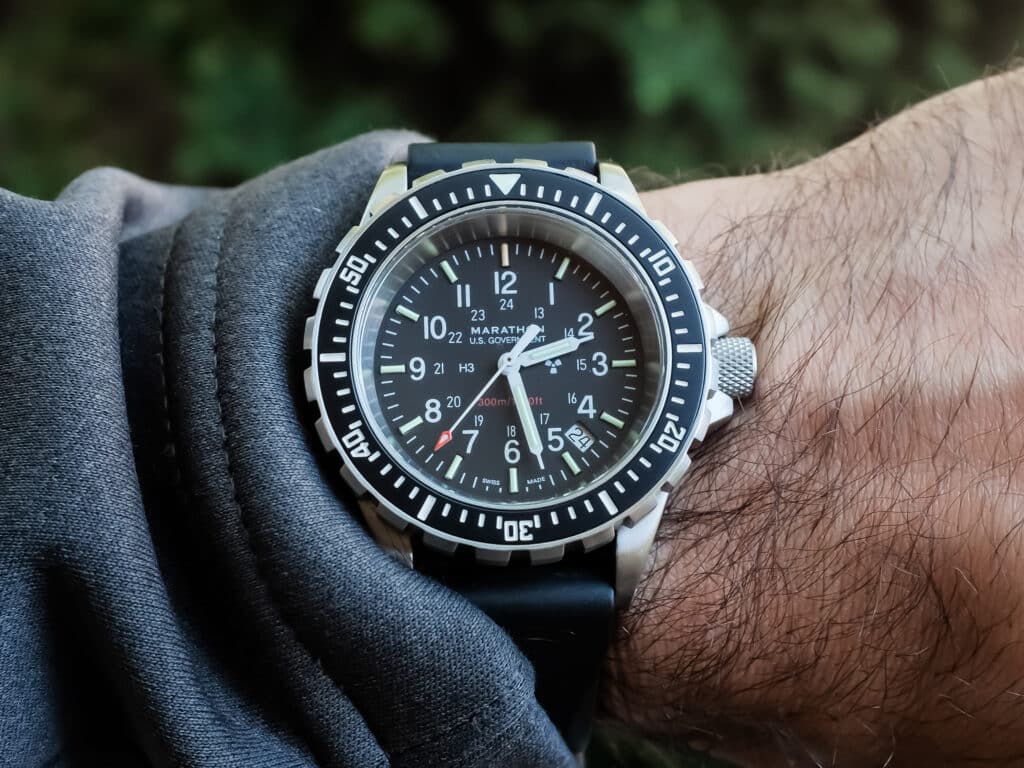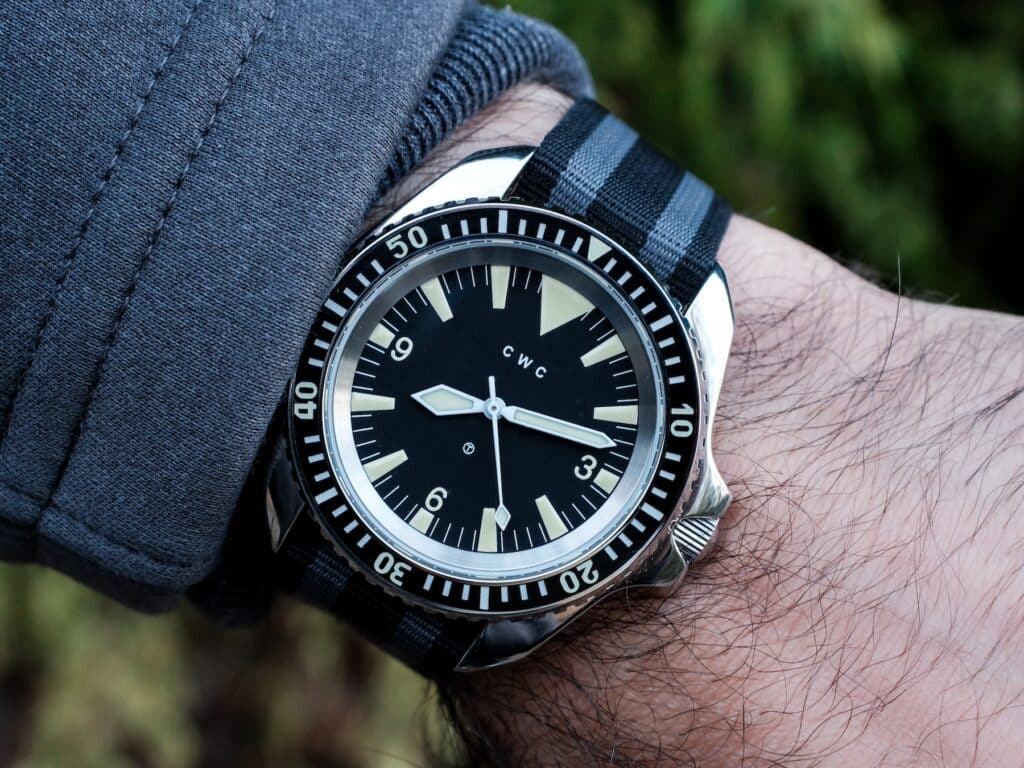Military watches have never needed to beg for attention—they’ve earned it the hard way. These are the pieces that started as a government-issued kit, not catalog fluff. We’ve spent years reviewing, wearing, and occasionally breaking watches that were built for the field first and collectors second. What keeps us coming back isn’t just the “military style” nostalgia; it’s how these designs still make sense today: simple, durable, legible, and always ready to be used, not babied.

The watches here were born from contracts, not concepts, and refined through decades of hard use. From cold-weather training runs to long weekends in salt water, we’ve tested the ones that have earned their place in honest service. We’ve reviewed the divers issued to Royal Navy units, the field timers made for pilots and SAR crews, and the quartz workhorses that outlasted mechanical legends. This list features military watches that still carry the DNA of service, yet fit easily into everyday life.
Marathon Navigator

| Price: | $420 |
| Water Resistance: | 60m |
| Case Dimensions: | 41mm (diameter) x 48mm (lug-to-lug) x 11mm (thickness) |
| Lug Width: | 20mm |
| Movement: | ETA F06 quartz |
The Marathon Navigator is one of those watches that makes you question why more brands don’t build things this straightforward. Initially designed for Kelly Air Force Base in the mid-1980s, it was created to serve pilots and navigators who required a lightweight, accurate, and durable instrument for use in the field. The version we tested features a composite fiber case that appears utilitarian but feels surprisingly sturdy. At over 40 grams on a nylon strap, it disappears on the wrist. The matte finish minimizes reflections, while the sapphire crystal, steel crown, and screw-down back add a welcome sense of refinement. The rotating bezel isn’t clicky; it turns with resistance instead, but once you get used to it, it’s a quick way to track a second time zone. Everything about this watch says “practical first, polish later.”
The dial is where the Navigator earns its keep. Ours came with the sterile version: no logo, no date, no distractions—only a crisp 12- and 24-hour layout and an even spread of glowing tritium tubes. The glow isn’t dramatic, but it’s constant, and in total darkness, it’s easy to read without frying your night vision. The contrast between the black dial, white indices, and pale tritium light makes it one of the most legible dials we’ve used, rivaling even larger flieger watches. We admit that there’s a quiet satisfaction to glancing down and seeing the time immediately, without any glossy reflections or clutter. Water resistance at 60m is modest, but enough for daily wear, and the fixed spring bars mean it’s built for nylon or leather pass-through straps.
Inside, the Navigator is powered by a high-torque ETA F06 quartz movement, the same workhorse found in several other Marathon models. It’s accurate, dependable, and the battery hatch makes replacement so simple you can do it with a coin. We found that setup refreshing: no tools, no servicing headache, just pop it open and go. That simplicity is what makes the Navigator such a great entry point into military-style collecting. At under $500, it offers real mil-spec credentials, everyday practicality, and an easy-wearing experience that mechanical field watches twice the price still struggle to match.
Pros
- Genuine military design with ultra-light composite case.
- Tritium illumination offers constant readability.
- Easy battery change via quick-access hatch.
Cons
- Bezel rotation feels sticky and imprecise.
- 60m water resistance limits actual dive use.
- The resin case can feel too light for those used to steel.
CWC SBS Diver

| Price: | $960 approx |
| Water Resistance: | 300m |
| Case Dimensions: | 45mm (diameter incl. crown) x 47mm (lug-to-lug) x 11mm (thickness) |
| Lug Width: | 20mm |
| Movement: | Ronda Swiss-made 517 quartz |
At first glance, the CWC SBS Diver doesn’t scream for attention, and that’s precisely the point. Built to meet the needs of the elite units of the British Forces, the Royal Marines and the Special Boat Service, it’s a tool first and a collectible second. The case feels dense and reassuring, heavier than its dimensions suggest, while the black PVD finish keeps it discreet. Swapping straps is part of the fun here; we tried everything from single-pass nylons to RAF-style options, and each brought a slightly different personality without losing that military practicality. The watch has that rare mix of restraint and toughness that makes you want to wear it everywhere: camping, commuting, or simply kicking around town.
The dial walks a fine line between busy and functional. Oversized hour plots and sword hands make legibility instant, even under low light, and the “circle L” marking subtly nods to its Luminova upgrade. The lume kicks in after a quick burst of sunlight and holds strong through most of the night. The flat crystal helped combat glare outdoors, while the quartz movement inside maintained accurate time within five seconds during our five-week testing period. That’s the beauty of quartz in real life: you set it once and forget about it, which makes this watch ideal for people who don’t want to fuss with winding or date resets constantly. Despite the rugged intent, it wears light, never feeling clunky or overbuilt.
The SBS Diver represents what many military watches strive for (but often fail to achieve): genuine functionality without theatrics. For collectors looking to add an authentic, dependable field diver to their rotation, this one’s hard to ignore.
Pros
- Authentic military heritage with proven field design.
- Excellent legibility and long-lasting lume.
- Accurate quartz movement with minimal upkeep.
- Easy strap changes make it versatile.
Cons
- Pricey compared to other quartz divers.
- Some may find the dial layout a bit crowded.
CWC 1983 Quartz Royal Navy

| Price: | $1,180 |
| Water Resistance: | 300m |
| Case Dimensions: | 45mm (diameter incl. crown) x 47mm (lug-to-lug) x 11mm (thickness) |
| Lug Width: | 20mm |
| Movement: | ETA 955.122 Quartz |
The CWC 1983 Quartz Royal Navy Diver is the kind of watch that earns your respect the more time you spend with it. There’s nothing ornamental or overdesigned here. It’s a tool built to do its job and survive whatever you throw at it. The asymmetrical case follows old Ministry of Defence specifications, with oversized crown guards and 300m of water resistance, which make it feel more capable than its size suggests. On the wrist, it wears comfortably like a no-date Submariner but with a rougher, more mission-ready attitude. On the included Phoenix NATO strap, it feels at home: light, balanced, and ready to take on anything.
The acrylic bezel is what drew our eyes first. It’s glossy, old-school, and captures the light in a way that feels straight out of the 1980s. The 60-click action is crisp with barely any slack, and the lumed 10-minute markers make timing a dive or even a coffee break dead simple. The matte dial keeps things clean with bold sword hands, thick markers, and that vintage-colored lume that glows long into the night. As also mentioned in our personal experiences with this timepiece, the “circle T” is now purely decorative, as the watch utilizes Super-LumiNova instead of tritium; however, the overall design still captures the military feel.
During testing, accuracy was tight, hovering between -0.3 and +0.5 seconds a day, and that quiet tick of the ETA 955.122 movement felt like reassurance. Sure, the day/date mechanism hiding under the dial makes setting it slightly awkward, but once you’re synced, you can forget about it for six years until the battery runs dry.
At its price point, it’s not an impulse buy, especially for quartz skeptics. However, the value lies in its purpose and history, not mechanics alone. This is a genuine British military diver made wearable for everyday use. For anyone seeking an authentic, low-maintenance piece with credibility and charm, the CWC 1983 Quartz Royal Navy Diver strikes the perfect balance.
Pros
- True MOD-spec heritage with rugged construction.
- The acrylic bezel offers a vintage charm and provides a satisfying tactile experience.
- Excellent legibility and long-lasting lume.
- Accurate, maintenance-free ETA quartz movement.
Cons
- The price may deter collectors who expect a mechanical movement.
- Faux “circle T” (without the use of Tritium) could feel inauthentic to purists.
- Fixed spring bars limit the strap’s flexibility.
Marathon TSAR

| Price: | $1,200 |
| Water Resistance: | 300m |
| Case Dimensions: | 41mm (diameter) x 48mm (lug-to-lug) x 14mm (thickness) |
| Lug Width: | 20mm |
| Movement: | ETA F06 quartz |
The Marathon TSAR is one of those watches that feels indestructible the moment you pick it up. Initially designed for Canadian Search and Rescue teams, it’s overbuilt, and every detail exists for a reason. The 41mm case is thick, thoroughly brushed, and slab-sided, giving it a tank-like presence without feeling clumsy. The 120-click bezel has deep, grippy teeth that make it easy to operate with gloves on. Even the oversized crown feels engineered for function first. On the wrist, it feels heavy but adds a reassuring feel.
As mentioned in our dedicated review, the black dial carries that same no-nonsense DNA. There’s a version marked “US GOVERNMENT” and another without, both clean and highly legible. The small red depth rating and tritium tube hour markers add enough visual energy to keep things interesting without overcomplicating the layout. The constant glow of tritium makes it one of the few watches you can truly read at any hour without charging it up first. We found the MaraGlo lume gives just enough light to be useful without being distracting, even in pitch darkness.
The ETA F06 quartz movement powering it isn’t a high-accuracy spec, but it’s built to drive Marathon’s heavy hands and stay within half a second per day. That’s pretty good for a watch meant to be ready at all times. The roughly three-year battery life fits the “set it, forget it, trust it” mindset that defines the TSAR. For straps, Marathon offers a choice between a solid steel bracelet and a pure rubber option. The bracelet is sturdy but stripped of modern comforts, such as micro-adjusts or quick releases. The rubber strap, though, feels right at home: thick, tough, and faintly vanilla-scented in that satisfying way Marathon fans know.
At roughly $1,200, it’s easy to look at the TSAR and question the price for a quartz watch, but that misses the point. Every detail feels ready for a job that most of us will never have to do. And yet, it’s such a satisfying piece to own. It’s a watch you can take into salt water, drop on concrete, or wear through a weekend of yard work without worry.
Pros
- Constant, low-level tritium illumination.
- Excellent bezel and crown grip for use with gloves.
- Reliable, accurate quartz movement with strong torque.
- Solid strap and bracelet options for any environment.
Cons
- The chunky case can feel bulky under sleeves.
- Short battery life compared to modern HAQ quartz.
- Polished edges and utilitarian styling limit the watch’s dress versatility.
- Lack of micro-adjusts or quick releases for easy strap replacements.
CWC 1980 Royal Navy Re-Issue

| Price: | $2,740 |
| Water Resistance: | 300m |
| Case Dimensions: | 41mm (diameter) x 47mm (lug-to-lug) x 12.7mm (thickness) |
| Lug Width: | 20mm |
| Movement: | ETA 2824-2, CWC-engraved |
The CWC 1980 Royal Navy Diver Re-Issue feels less like a nostalgic re-creation and more like a faithful continuation of the watch that once lived on the wrists of Royal Navy divers. From the first wear, it’s clear this isn’t a lightweight reinterpretation; it feels sturdy and confident. Despite measuring around 41mm, it wears more compactly, much like a ’90s Submariner, thanks to its polished case and curved profile. The fixed spring bars limit strap choices, but that’s part of the charm (and a military spec requirement). We tested it on the included Cabot Military Watch Strap and later on a Phoenix Bond NATO, both of which reinforced how versatile and comfortable it is for daily wear. This isn’t a “desk diver” piece; it feels equally at home on a hike, in the water, or doing everyday life.
What stood out most during our wrist time was how well CWC balanced vintage cues with modern practicality. The dial nails that classic mil-sub simplicity with the small CWC logo and the circle-T marking, now replaced with vintage-tinted Super-LumiNova. But compared to the older versions, the modern lume color doesn’t quite hit the mark. The lighter vintage tone on the original had enough warmth to feel authentic, whereas the current options lean too far in the opposite direction. The bright white lume feels sterile, almost clinical, while the darker “pumpkin” tone looks forced, like an imitation of age. It’s a small detail, but for collectors who care about character, it stands out.
During testing, the sapphire crystal effectively minimized glare, even in midday sun, and the trapezoidal markers, paired with sword hands, provided near-pilot-watch legibility. The ETA 2824-2 movement inside performed better than expected after regulation, running within approximately 3 to 5 seconds per day. You can wear it for months without worrying about accuracy or service complications.
The re-issue’s magic lies in how honest it feels. It wears like a serious instrument rather than a collector’s prop. For those already deep into tool watches or anyone who has flirted with mil-sub homages, this is the one that makes you stop chasing. It’s pricey for a niche piece, but every detail, from the bezel action to the case finishing, feels like it was built to outlast trends.
Pros
- Faithful execution of an actual military-issued design.
- Strong lume and legibility in all light conditions.
- Versatile strap compatibility for daily use.
- Dependable ETA 2824-2 movement, easily serviceable.
Cons
- The fully polished case is easily prone to picking up hairline marks.
- Modern lume tones fall short compared to earlier versions.
- Premium price for a niche, historically focused diver.
- Slight bezel wobble is noticeable during handling.

Co-Founder and Senior Editor
Kaz has been collecting watches since 2015, but he’s been fascinated by product design, the Collector’s psychology, and brand marketing his whole life. While sharing the same strong fondness for all things horologically-affordable as Mike (his TBWS partner in crime), Kaz’s collection niche is also focused on vintage Soviet watches as well as watches that feature a unique, but well-designed quirk or visual hook.
The Vertex 36mm field watch comes to mind here.
Yes, and I have one. The author never heard of them.
Hi, Marcus:
Glad to hear you agree that the Vertex is a good fit. We’ve certainly aware of Vertex however we haven’t had the opportunity to review one directly. As soon as we do, we’ll place it into consideration for inclusion on this list in an upcoming update.
Best,
-Kaz
The only true military watch is a GPS cuz you have to have 24 hours to operate.
Hi, Gene:
For the sake of reality and practicality, you’re correct to an extent for sure. The best fit for any particular military situation is the one that offers the best combination of reliability and technology (like a GPS). However, we’ve had enlisted guests on the TBWS podcast before who have shared that sometimes the have to enter certain parts of a base or be in a briefing room where connected devices aren’t allowed for security purposes. For that reason, many service-folk stick with simple, 3 hander non-connected watches. So it really just depends what the particular application of the watch is in the military context.
Best,
-Kaz
The Elliot Brown Holton professional quartz should have been included as this is a true military designed and issue watch.
Hi, Steve:
We’ve actually heard fantastic things about Eliot Brown. We didn’t feature them in this list here because we haven’t actually performed a formal test and review of one for the site. Your note is a great reminder though that we should absolutely try to contact EB and see if it’s possible to conduct a review for them in 2026.
Thank you!
-Kaz